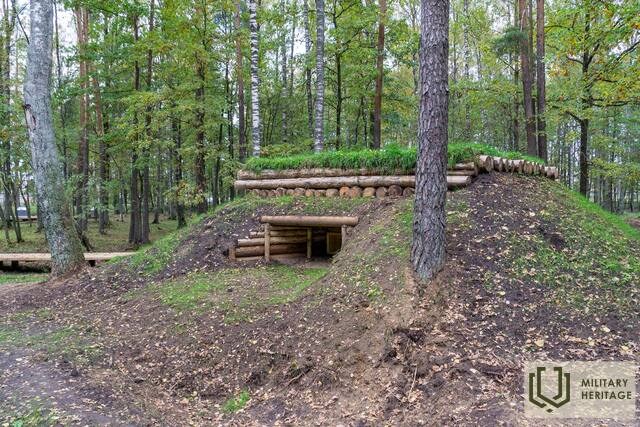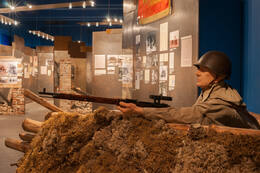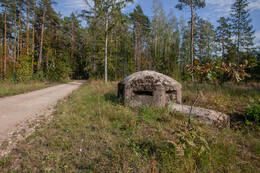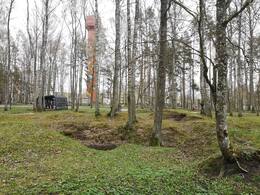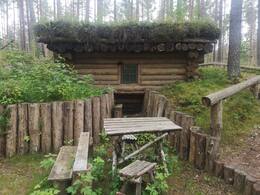Блиндаж
I Первая мировая война, I Освободительные войны, II Вторая мировая война, IV Оккупация Советами и Холодная война
Также бункер, от французского blindage. Фортификационное сооружение из дерева и земли для проживания солдат, обеспечивающее защиту от артиллерийского огня.
Конструкция блиндажа обычно напоминает сруб, полностью зарытый в землю. Эти сооружения строились в основном для размещения штабов, полевых госпиталей и мест отдыха личного состава.
Одним из важных факторов является невидимость сооружения. Это позволяет обеспечить максимально возможную безопасность персонала.
В зависимости от наличия материалов для строительства земляных убежищ могут использоваться земляные, деревянные, железобетонные, каменные и металлические конструкции.
Связанные объекты
Военный музей Латвии
Военный музей Латвии находится в Старой Риге, недалеко от Памятника Свободы, в Пороховой башне - старинном оборонительном сооружении. В музее 11 экспозиций. На выставке представлено различное оружие, документы, униформа, награды и другие предметы, относящиеся к войне и повседневной жизни солдат. Военный музей Латвии - один из старейших музеев Латвии. Его история началась во время Первой мировой войны. Коллекция музея создана в основном из предметов с полей сражений и личных вещей солдат. После создания Латвийского государства основной целью музея стало создание экспозиции о военной истории Латвии и активной роли ее жителей в защите своей земли.
В 1937 году музей был расширен за счет пристройки и технически был одним из самых современных музеев того времени в Европе. Пороховая башня - одна из бывших крепостных башен Риги. Упоминается в 1330 году как Песчаная башня. В 1621 году, когда Рига была окружена шведскими войсками, башня была разрушена. В 1650 году была построена новая башня для хранения пороха и оружия. После сноса городских укреплений Пороховая башня - одно из самых ценных свидетельств оборонительной системы Риги.
Огневая точка из бетонного бункера возле села Гауя
Расположен в Инчукалнском крае, на обочине дороги около поселка Гауя, недалеко от перекрестка автомагистралей А2 и А3.
Это укрепление представляет собой очень редкий и ценный образец фортификационного искусства. Оно было спроектировано для наблюдения одним наблюдателем за важным транспортным узлом. На северо-западе находится мост через Гаую, на востоке — переправа через Инчупите, на юго-западе — дорожная развязка, а на юге — одна из основных транспортных магистралей — Видземское шоссе. Железобетонное укрепление было частью окружающих окопов, точное время строительства которых неизвестно. Скорее всего, оно было построено немецкой армией во время Второй мировой войны. Для уточнения информации требуется дальнейшее исследование объекта.
В конце XIX века территория вокруг усадьбы Инчукалнс превратилась в важный транспортный узел. Во время Первой мировой войны эта территория приобрела значение оборонительного района, где планировались возможные военные действия. Укрепления были построены вблизи транспортных путей, железнодорожной станции Инчукалнс и переправы через Гаую. Территория сохраняла своё стратегическое значение и в последующих войнах.
Сегодня вы можете осмотреть укрепление, доступ к которому свободен.
Землянки и окопы латышских стрелков в Тирели (Tīreļi)
Землянки и окопы латышских стрелков в Тирели находятся в Бабитской волости Марупского района, недалеко от Антиньского кладбища латышских стрелков и бывшего склада медикаментов. Во время Первой мировой войны здесь находились оборонительные позиции латышских стрелков Российской Императорской армии. В песчаных холмах построен комплекс траншей и наземных землянок. Окопная, позиционная, траншейная война - самые популярные синонимы, описывающие Первую мировую войну и подчеркивающие важность укреплений. Они были созданы на основании исследований военных инженеров, адаптированы к окружающей среде и развитию новых вооружений. Ежедневная работа солдат заключалась в постоянном укреплении обороны.
Они давали землянкам имена, напоминающие о родных местах, чтобы мысленно быть ближе к дому, забывая о реальности войны. Линии траншей противнику занять было сложно. По мере развития вооружений их защита становилась все труднее. Крыши землянок были укреплены, чтобы выдерживать попадание артиллерийских снарядов. Траншеи были вырыты с изменением направления, чтобы взрывы причиняли как можно меньший ущерб. Транспортные проходы образовывали «карманы» - временные укрытия во время артиллерийского огня, защищавшие солдат от шрапнели и осколков. Сегодня часть укреплений отреставрирована, есть возможность осмотреть 3 восстановленных землянки и участок траншей длиной 100 м.
Частная коллекция «Семейный амбар»
Частная коллекция «Семейный амбар», расположенная в родовом поместье «Абелю Путнини», была создана в 2007 году и раскрывает историю одной семьи через истории, предметы и реконструированное убежище.
Посетителям предлагается экспозиция, знакомящая с историей Первой мировой войны, Латвийской армии, Второй мировой войны, Братского кладбища в Риге и Рождественских боев. В старом амбаре представлены вышитые скатерти, самодельные народные костюмы, шкаф с посудой, лыжи и колесо от колесницы, подаренное бароном Корфом. В 2011 году началось обустройство отреставрированного убежища из берёзовых дров. В нём находятся печь, спальный отсек и стенды с предметами, связанными с Первой мировой войной: разбитая посуда, фотографии и ржавые детали оружия. Экспозиция позволяет посетителям ощутить события Первой мировой войны, описанные в романе Александра Грина «Метель душ». Особое внимание уделено 4-му Видземскому стрелковому полку и Рождественским боям. Упоминаются следующие солдаты: Роберт Сокс, похороненный на Братском кладбище в Риге, а также писатели Александр Гринс, Янис Акуратерс, композитор Арвидс Жилинскис и другие.
На территории выставки можно увидеть бомбёжки времён Первой мировой войны и источник, из которого солдаты брали питьевую воду. Экскурсия по объекту длится 1,5–2 часа и доступна на латышском и русском языках.




